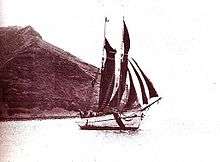Mana Expedition to Easter Island


The Mana Expedition to Easter Island (Polynesian: mana means "good luck") occurred between March 1913 and August 1915. It was the first archaeological expedition to Rapa Nui which was privately organized and funded, preceding the Norwegian Archaeological Expedition to Easter Island of Thor Heyerdahl by more than 40 years. The Mana Expedition was led by Katherine and William Scoresby Routledge.[1] The expedition and its ship, the Mana, bore the same name.[2] The ship left Falmouth, England on March 13, 1913 with a crew of twelve, including a surveyor, geologist, sailing master, navigator, engineer, cook, seamen, a cabin boy and the Routledges. They arrived on the southern coast of the island at Hanga Roa Bay, by way of the Strait of Magellan, on March 29, 1914, setting up their first camp at Mataveri, on the island's southwest corner.[3] The English archaeologist O. G. S. Crawford referred to the expedition as "an archaeological fiasco".[4]
References
- ↑ Van Tilburg, Jo Anne. "Page 1 THE MANA EXPEDITION TO EASTER ISLAND (Rapa Nui): ARCHAEOLOGY AND ETHNOLOGY IN LIGHT OF HISTORY" (PDF). Easter Island Statue Project. Retrieved 21 July 2012.
- ↑ Pelta, Kathy (1 February 2001). Rediscovering Easter Island. Twenty-First Century Books. pp. 64–. ISBN 978-0-8225-4890-4. Retrieved 21 July 2012.
- ↑ Pelta, p. 64
- ↑ Tilburg, JoAnne Van (1 April 2003). Among Stone Giants: The Life of Katherine Routledge and Her Remarkable Expedition to Easter Island. Simon and Schuster. p. 97. ISBN 978-0-7432-4480-0. Retrieved 21 July 2012.